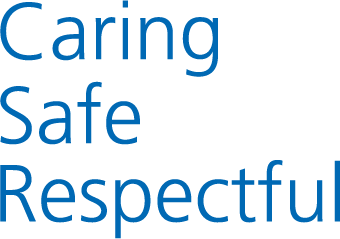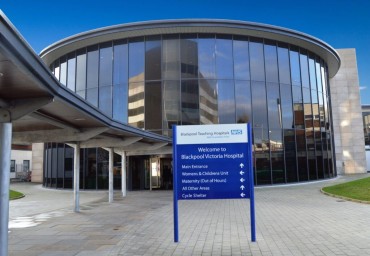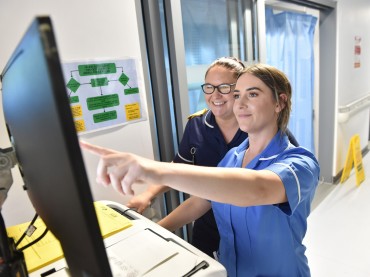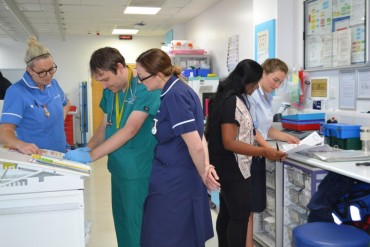It is important to remember that no treatment is without risks. When your doctor offers you a particular type of treatment they are trying to decide the best option for you based on the associated risks and benefits to each possible treatment.
In coming to a decision about your treatment they will have taken into account many things such as recent trial outcomes, statistics and past experiences with similar situations. It is essential to remember that you have your own say in your treatment.
Our doctors will try to present the facts to you in a way that you can understand to help you make the decision and it is important to ask questions so you and your family know what is happening and why. If there is anything you do not understand ask the doctor, the nurse or any of the healthcare professionals involved – we are all here to help you.
The Lancashire Cardiac Centre offers many types of treatment which vary from surgery, to less invasive cardiac catheter procedures to medication.
For the majority of patients our Outpatient clinics will be their first time in the Lancashire Cardiac Centre, and serves as our first line where patients will discuss their condition with their doctor in comfortable, clean surroundings. From this point in your journey the doctor will discuss your options are may start medications or refer you for further investigations.
After you have had the tests requested by your specialist doctor they may request to see you in clinic with the results or may need more test / investigations or recommend the next stage of treatment.
There are numerous tests that can now be done to diagnose your heart condition effectively. Most of these tests are non-invasive so there is no need for surgery or the removal of any bodily tissues.
Electrocardiograms (ECGs)
This is a recording of the electrical activity of the heart and is used to diagnose heart rhythm problems. It can show if you have had a heart attack or if your heart is strained or enlarged. Several small sticky tabs are attached to your arms, legs and chest which are connected to a recording machine. The test takes about five minutes and is not painful or uncomfortable.
Echocardiography
Similar to pregnancy, echocardiography is an ultrasound but of the heart. A probe is placed on your chest and ultrasound waves are used to investigate and display the action of the heart as it beats on a screen. It is usually used on people who doctors may suspect of having leaky or stiff valves or patients who have suffered a heart attack. The test can take up to an hour but is not painful.
Exercise Testing
Electrocardiograms (ECGs) are used to monitor how the heart reacts to exercise, so you will usually be asked to walk/run on a treadmill. If you have chest pain symptoms, the test helps to show if these are caused by a lack of blood flow to the heart and if so, how serious it is. It is also used after heart surgery to assess what level of exercise should take place as part of your rehabilitation. The test usually takes about 15 minutes.
Holter Monitoring
This is where the heart rate is monitored over several hours, some devices record for 24, 48 or 72 hours, some are worn all the time and “activated” when a patient has an occurrence of a symptom. A portable ECG machine records the signals from the heart while you are at home. The recording device is either attached to a belt or a strap which goes across the chest. You might also be asked to fill out a diary of events such as exercise, sleep and symptoms. The recording can then be analysed by a Cardiac Physiologist.
Myocardial Perfusion Scan
A Myocardial Perfusion Scan is used to evaluate how strong the blood supply to your heart muscle is. Under stress the heart may not receive enough oxygen at times and this may result in chest pain called angina or breathlessness. The scan uses a small amount of radioactive substance (thallium or technician) which, along with gentle exercise (or medicine used to simulate exercise) can be used to produce pictures of your heart. When the radionucliotide is injected into the blood stream it travels to the heart muscle through the coronary arteries. The process can be visualised by a special camera.
Angiography
This is an x-ray of the arteries, used to diagnose blockages or other abnormalities of the blood vessels. A thin tube called a catheter is inserted through a small nick in the skin into an artery. The cardiologist guides the catheter into the artery to be studied whilst watching on an x-ray monitor. A dye is then injected through the catheter while x-rays are taken to view the blood vessels. The test takes between 20 minutes to an hour and you should not eat or drink before hand.
Blood Tests
It is possible to tell if you have had a heart attack by examining the enzymes and proteins in your blood through a series of samples. An analysis of protein in your blood also helps to show the extent of damage to the heart muscle.
Blood tests are also performed so your doctor can assess particular chemical levels in the blood to check that other problems are not causing your symptoms, and also to make sure you are well enough to undergo certain tests.
Tilt Test
A tilt test is performed to assess symptoms of dizziness, blackout, blood pressure response and pacemaker function. During the test you will be asked to lie on a table where you will be connected to an ECG machine and blood pressure monitor. The table will then be tilted, head up, for a period of time. Your heart rate and blood pressure will be constantly monitored throughout.
You will also be asked to stand throughout the test but you will be supported by the table and will not be expected to stand for longer than 45 minutes. You will be allowed to rest after the test before you go home. You will usually be in the department for around one and a half hours and it is advisable to bring a friend as you cannot drive immediately after the test.
Treatment
We presently have 4 cardiac catheter laboratories where angiograms, angioplasty, ASD/PFO closures, valvuloplasty, trans-aortic valve implantation, cardioversion, pacemaker, biventricular pacemakers and ICD implantations take place Our pacemaker laboratory been updated to provide a combination laboratory where cardiac catheter procures and pacemakers can take place along with developing our electrophysiology service which serves to investigate and treat irregular electrical pathways in the heart (irregular heart rhythms).
Angiogram and Angioplasty
If you are asked to attend for an angiogram or a procedure known as angioplasty, a technician will attach electrodes to your arms and legs to enable us to monitor your heart. During the procedure a local anaesthetic will be administered to the access site in your arm or leg and x-ray equipment moved into place around your chest while the cardiologist feeds a thin hollow tueb called a catheter through your artery (wrist or groin). Depending on the particular treatment you are to undergo, the duration of the procedure could be between 30 minutes and two hours.
Percutaneous Coronary Intervention (PCI)
PCI is a treatment procedure that unblocks narrowed coronary arteries without performing surgery. This can be done in various ways:
Balloon catheter angioplasty
During this procedure, the cardiologist inserts a cardiac catheter with a small balloon around it into the coronary artery. The cardiologist then places the balloon in the narrowed area of the artery and expands it . This pushes the blockage to the sides of the artery where it remains. This technique reduces the narrowing in the artery . The cardiologist removes the balloon catheter at the end of the procedure.
Stent
The cardiologist places a small, hollow metal (mesh) tube called a “stent” in the artery to keep it open following a balloon angioplasty. The stent prevents constriction or closing of the artery during and after the procedure. Drug-eluting stents are now used. These stents are coated with medication that helps prevent re- narrowing of the artery.
Internal Cardioversions
A large number of patient in cardiology suffer from an abnormal heart rhythm known as atrial fibrillation (see glossary), and a procedure called a cardioversion attempts to stop this abnormal rhythm and put the heart back into a normal sinus rhythm .
A catheter (thin tube) is fed, under local anaesthetic into a vein in your groin up to the right side of your heart. When at the correct location in your heart sedation is given and when you are asleep a small shock is applied through the chambers causing the problem. This is very effective at stopping the abnormal rhythms but may only be considered if you have had an external cardioversion that hasn’t stopped the rhythm.
Closure of septal defects
Atrial septal defect (ASD), ventricular septal defect (VSD) and patent foramen ovale (PFO) are the most common heart defects that adults present with, having them from birth. They are characterised by the persistence of one or more holes in the upper or lower chambers of the heart with communication present between either the left and right atria or left and right ventricles. Patients presenting with a ‘’stroke’’ (cerebrovascular event) relatively young in life are now fully investigated to exclude a PFO by echocardiography.
Endovascular closure of a septal defect or PFO involves making a small incision in the groin to introduce a guidewire into the femoral vein which is threaded up into the heart, through the defect. A delivery sheath is then advanced over the wire across the defect (or hole). An occluder device is advanced through the delivery sheath and expanded so as to close the defect under echocardiographic and X-ray guidance. Patients can usually go home the following day after the procedure.
Valvular intervention
A small number of patients are suitable for stretching of a narrowed valve of the heart, using balloon technology. Most patients have narrowed valves replaced by surgery but sometimes this isn’t feasible.
Catheter laboratory based valve procedures are explained below:
Valvuloplasty
Valvuloplasty is the repair of a stenotic valve using a balloon catheter inside the valve. The balloon is placed into the valve that has become stiff from valve thickening and calcium build-up. The balloon is then inflated in an effort to increase the opening size of the valve and improving blood flow.
Transcutaneous Aortic Valve Replacement (TAVI)
Transcutaneous aortic valve implantation (TAVI) has been designed to treat patients who would be at high risk during standard cardiac surgery. TAVI allows aortic valve implantation without the need for opening the chest or cardiopulmonary bypass. The procedure may be performed from the leg artery or neck artery depending on the size of the blood vessels.
Lancashire Cardiac Centre has been selected to take part in a clinical evaluation of this procedure and we look forward to its use to help improve the quality of life of patients with valvular disease.
Pacemakers, Biventricular pacemakers and internal cardio-defibrillators (ICDs)
Patients suffering from dizzy spells and faints/blackouts are all investigated thoroughly to examine if the cause is due to slow, irregular heart rates. Patients that are found to have slow heart rates causing them symptoms may go on to have a pacemaker fitted.
Biventricular pacemakers are fitted to patients that are suffering from heart failure and the device works to re-synchronise the heart ensuring both ventricles are pumping together. This has been seen to decrease patient’s symptoms (breathlessness, ankle swelling, reduction in activity)and also to increase their quality of life.
Patients are fitted with ICDs due to either episodes of dangerous irregular rhythms or a high chance of them developing these rhythms.
The devices work by either giving a small shock to terminate the fast irregular rhythms or by using a fast pacemaker to work faster then the abnormal rhythm and break the fast cycle.
All these devices (Pacemakers, Biventricular pacemakers and ICDs) are inserted in a similar way using a vein near the collar bone and a pocket made deep under the skin layers to the top left or right of the chest. The leads are fed to the heart through the vein and the device is inserted in the pocket.
Patients will stay in over night and have a pacemaker check (see pacemaker clinic) and an X-ray the next day.
Electrophysiology Service
Electrophysiology is the medical specialty of heart rhythms. It is a diagnostic procedure to look more closely at the electrical function of your heart. It is the most accurate and reliable method of evaluating your heart rhythms and will help your physician determine the treatment option that is most appropriate for you.
The different types of surgery we perform are listed here, along with a brief explanation about anaesthesia.
Coronary Artery Surgery
Coronary Artery Bypass surgery aims to bypass blocked arteries around the heart using veins taken mainly from patient’s legs. This process, known as revascularisation, can relieve symptoms such as tightness, choking, heaviness and shortage of breath.
Valvular Surgery
Valve disease is essentially a mechanical problem and responds particularly well to surgery. These can either involve conserving the valve to restore function or, more frequently, replacement of the valve.
Surgery of the Aortic Arch
This procedure is performed on the main artery supplying the body with blood. It is necessary when an aneurysm ‘a bulging’ has developed and there is a potential danger that this will rupture.
Surgery for Lung Cancer
Historically surgery in lung cancer has been reserved for patients in whom there is a high probability of cure. Many patients with lung cancer will have been life time smokers and therefore are likely to also have ischaemic heart disease. Expected outcomes for a particular cancer depend on its cell type, size of the primary tumour, anatomical position and evidence of any spread. For this reason it is appropriate that the probability of cure is discussed on an individual basis with the appropriate consultant.
Oesophageal Surgery
This is performed on the gullet which is the tube that takes food and drink from the mouth to the stomach. Surgery is generally performed for concerns of ruptures. This is considered to be major surgery which will lead to a lengthy stay in the Intensive Care Unit and ultimately discharge from hospital.
Anaesthesia
As part of the pre-operative assessment the consultant anaesthetist will usually discuss the planned anaesthetic and post-operative pain relief management. For cardiac surgery this will generally include the insertion of monitoring lines, drips and catheters. Intra-thecal injections of opiates are often used, as are intravenous opiates in the post-operative period.
Two major functions in cardiac surgical terms, those of simple post-operative recovery for most patients and true intensive care for a comparative few.
Your GP or cardiology doctor may prescribe drugs to help with your heart condition. They might be used on their own or in conjunction with other therapies such as stents.
This page contains information about drugs used in the treatment of cardiac conditions. It tells you what each of the prescribed drugs will do, what the side effects are and the instructions on how to take them. These may have been prescribed by your GP or following a visit to our outpatient clinic here at the Cardiac Centre.
ACE Inhibitors
These drugs stop a substance called ACE (Angiotensin Converting Enzyme) working. They make the blood vessels relax, reducing blood pressure and the work your heart has to do.
Amiodarone
This regulates your heartbeat by affecting the rate electrical impulses pass through the heart. To build up the level of amiodarone in your body more quickly you will need to take more tablets at the beginning of your treatment. After a couple of weeks you may only need to take tablets once daily.
Aspirin
Aspirin helps prevent blood clots forming in the blood vessels that feed the heart muscle. Clots can block these vessels causing heart attacks. Low dose (dispersible) Aspirin means that the dose – 75mg, 150mg, or 300mg – taken once per day – is still small compared to that taken for pain relief or fever.
Beta-Blockers
These enable your heart to work more efficiently. They make the heart rhythm more regular and relax the blood vessels. A small dose is usually given at the beginning of treatment and then gradually increased depending upon patient needs.
Calcium-channel blockers
This is a large group of medicines. Each has a slightly different effect on your heart and blood vessels. Some widen the blood vessels, including those that supply your heart.
Clopidogrel
Clopidogrel helps to prevent blood clots forming in the blood vessels that feed the heart and brain. Clots can block these vessels and may cause heart attacks or strokes.
Digoxin
Digoxin has different effects on your heart. It can make your heart beat more slowly and regularly if you have an irregular heartbeat. It will also strengthen the pumping action of the heart making the heartbeat stronger.
Diuretics
These are used to reduce excess water from your body. They will make you pass water (you will have to go to the toilet more often). Removing excess water will reduce blood pressure. But they also help to reduce the symptoms of heart failure by removing fluid from your lungs, making breathing easier and reducing ankle swelling.
Nicorandil
This drug relaxes the muscles in the walls of your veins and arteries, which reduces the workload on your heart, and improves the supply of oxygen to your heart muscle.
Nitrates
Used mainly in the treatment of Angina, Nitrates work by opening up the blood vessels leading to the heart. This increases the blood supply to the heart and prevents or stops chest pain. Glyceryl trinitrate (GTN) comes in tablet form and spray container. Both work very quickly to reduce chest pain. Isosorbide mononitrate is a longer lasting tablet which when taken can give round-the-clock prevention from angina attacks.
Spironolactone
Spironolactone prevents a substance in your body called ‘aldosterone’ from working. Aldosterone makes your body retain water. By stopping it working, the drug enables your body to retain less water. This reduces the amount of ankle swelling and breathlessness that you may be suffering from.
Statins
Sometimes known as Lipostatins or Avrostatins they have roughly the same function and that is to reduce the amount of cholesterol in the blood. Cholesterol is a fat that can clog up the blood vessels and therefore reduce the blood flow to the heart.
Warfarin
This is used as an anticoagulant – that is to say the drug ‘thins’ the blood, making it difficult for your blood to clot. You will need regular blood tests whilst you are on Warfarin and it is important that you attend for the tests, on time, when they are requested. The tests will be weekly at first, but the frequency will increase once you are on a stable dose.
After your treatment (either medication, angioplasty or surgery) your doctor will want to follow you up in clinic. This works to let us know how well the treatment is going, if you have experienced any problems and if anything further needs doing to enhance your treatment.
Some treatments will require regular follow up visits in our outpatient clinics, such as the pacemaker and heart failure clinics.



